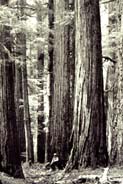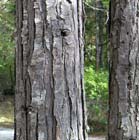Conservation Status

Chamaecyparis lawsoniana
(A. Murray) Parlatore 1864
Common names
Port-Orford-cedar, white or Oregon cedar, ginger pine, Lawson cypress; シダレイトスギ [Japanese].
Taxonomic notes
Syn: Cupressus lawsoniana A. Murray 1855 (Michener 1993). Detailed genetic analyses by Wang et al. (2022) find that both plastid and nuclear phylogenies group Chamaecyparis lawsoniana with C. obtusa, native to Japan and Taiwan; the two taxa share a common ancestor about 48 million years ago, which is about the same time as the fundamental split between Asian and North American taxa in the ancestral Cupressus clade, and which coincides with the mid-Eocene warm period, at which time the high northern latitudes supported many plants that we now think of as warm-temperate or subtropical.
Description
Trees to 50 m tall and 300 cm dbh. Bark reddish brown, stringy, 10-20(25) cm thick on old trees (1-2 cm thick on trees less than c. 100 years old), divided into broad, rounded ridges. Branchlet sprays predominantly pinnate. Leaves of branchlets mostly 2-3 mm, apex acute to acuminate, facial leaves frequently separated by paired bases of lateral leaves; glands usually present, linear. Pollen cones 2-4 mm, red to purple; pollen sacs red. Seed cones maturing and opening in 6-7 months, 8-12 mm broad, glaucous, purplish to reddish brown, not notably resinous; scales (6)8-10, the apical pair fused. Seeds 2-4 per scale, 2-5 mm, wing equal to or broader than body. Cotyledons 2. 2n = 22 (Michener 1993, Frankis 1999). See García Esteban et al. (2004) for a detailed characterization of the wood anatomy.
Distribution and Ecology
USA: From Coos Bay in SW Oregon to the Klamath River in NW California near the coast and locally to 1700 m in the Siskiyou Mountains and Mt. Shasta area. Prefers sandy and clay loams and rocky ridges. Usually in mixed, but sometimes pure stands. Climate cool Mediterreanean with summer fog (Little 1980, Michener 1993, Oregon Trees website). Hardy to Zone 6 (cold hardiness limit between -23.2°C and -17.8°C) (Bannister and Neuner 2001). See also Thompson et al. (1999).
Distribution data from GBIF (2024).
Of all major forest trees found in western North America, this species has suffered most from human activity. Nearly all old-growth forests have been logged, and most of the remaining trees in habitat are under threat from an introduced root disease caused by a strain of Phytophthora lateralis, one representative of a large group of plant pathogens. First found in a Seattle area nursery in 1923, the pathogen is believed to have been introduced from Asia, where it occurs naturally in Taiwan. It has since spread through much of the range of Chamaecyparis lawsoniana, eliminating stands in some areas and threatening the commercial status of the species throughout its range (Sniezko et al. 2012, 2020). The root rot has spread through habitat, killing trees of all ages, and has also killed ornamental stock both in the USA and in Europe (Robin et al. 2010). The spores are spread via water or are transported by people, machinery, and animals, and through root grafts (Zobel et al. 1985). Therefore, it has been critical for the conservation of this species to close roads and restrict further road construction in watersheds that contain uninfected stands (FEMAT 1993). Since 1997, the Dorena Genetic Resource Center, funded by the U.S. Forest Service and Bureau of Land Management, has been conducting a program to develop populations of C. lawsoniana with genetic resistance to P. lateralis. This program has yielded progeny with significant levels of resistance. Most resistant seedlings are progeny of crosses from parent trees that exhibited apparent resistance to the disease in earlier trials, and these trials have shown that both major gene resistance and disease resistance occur in the resistant seedlings. Many field trials are underway, seed orchards have been established, and resistant seed is now in use for restoration and reforestation in habitat (Sniezko et al. 2012, 2020).
Remarkable Specimens
The current largest living tree has a 365 cm dbh, height 69.8 m, crown spread 12 m, located in Siskiyou National Forest, OR (Van Pelt 1998). The tallest known is 81.08 m and 280.4 cm dbh, in Jedediah Smith State Park, California. This tree, measured in May 2009, had live foliage up to a height of 77.42 m with a spike top above that (Steve Sillett e-mail 2009.05.21). In June 2018, Mario Vaden and Chris Atkins found a 73 m tall tree, also in Jedediah Smith State Park (Vaden email 2018.06.27). A precise height measurement is pending on this tree, shown here in a photo; it also has a spike top. The next-tallest known tree is 72.8 m tall, located in the Coquille Falls Research Natural Area, Siskiyou National Forest, Oregon (tree measured by R. Van Pelt and C.J. Earle, 1999.05.13).
Much larger trees have been logged, a fate that befell the vast majority of trees within the native range of this species. Frank Callahan (email, 2009.06.23) reports that "In 1965, Eric Rutquist (Coos Bay, Bureau of Land Management timber cruiser) and I measured a stump averaging 17 feet [5.18 m] in diameter at 12 feet [3.66 m] above the averaged base (the tree was on a slope). The above ground footprint of the tree was ca. 24 feet [7.32 m] in diameter as the tree exhibited extreme buttressing below the 12 foot cut. At the stump-cut, Eric and I counted 1755 rings after scraping off the moss and noted that this was a single tree as the ringcounts matched from two different radius points. The bole (from previous cruise reports) was branch free for 180 feet [54.86 m] and the total height was 245 feet [74.68 m] taken by clinometer and actual length of felled log (upper Coquille River, Coos County, Oregon). The tree was alive and in good condition when it was felled (from older photographs)." Frank also reports that the BLM has since discarded all photographs and records documenting this tree.
The oldest known specimen, 418 years, is documented in a tree-ring chronology covering the period 1420-2000 (fully crossdated), collected on Page Mountain, Oregon by Allyson Carroll and Erik Jules (doi.org/10.25921/pecm-3d66). The 418-year lifespan was shown in one dead tree, dated 1540-1957. The chronology was used in a study of Phytophthora lateralis effects on the species (Jules et al. 2002). Besides this, Frank Callahan (email 2011.01.07) reports a stump that he counted in 1965 as having 1,755 rings, verified on two different radii; see above quote.
Ethnobotany
The white, aromatic wood is highly valued by the Japanese for shrines, temples and arrow shafts (Little 1980). Originally used for uses as diverse as shipbuilding and match sticks, it is now the most valuable wood harvested in western North America, thanks to past overexploitation. Many cultivars are used as ornamentals (Little 1980); it is the most important ornamental conifer species in the U.K., seen mostly as semi-dwarf cultivars in parks and gardens, and planted to the exclusion of many far more interesting species. Welch and Haddow (1993) list 559 cultivar names (many of them illegitimate), of which only about 30 to 40 account for nearly all of the trade (Frankis 1999).
Observations
An old growth stand is preserved in the Coquille River Falls Research Natural Area, Coos County, Oregon, and in general the species reaches its best development in the Coquille River Valley.
The species is also well represented at Adorni Research Natural Area just west of Aikens Creek Campground on highway 96 in Six Rivers National Forest, California. The area is at 41° 13' N, 123° 41' W. Parts of the site were logged in the 1960's, but it is generally a good example of the species at a low elevation site. In this stand, it is codominant with Douglas-fir (Pseudotsuga menziesii subsp. menziesii) above a subcanopy of tanoak (Lithocarpus densiflorus) and madrone (Arbutus menziesii); all of these species are regenerating on the site as well. The stand also contains incense-cedar (Calocedrus decurrens) and sugar pine (Pinus lambertiana) (Keeler-Wolf 1990).
The highest known stands are found in the Cedar Basin Research Natural Area, around Cedar Lake, Cliff Lake, Upper Cliff Lake, and Terrace Lake at the end of Forest Road 26 in Shasta-Trinity National Forest, California. The area is at 41° 12' N, 122° 27' W. Some of the trees are remarkably large, approximately 120 cm dbh and 400-500 years old, and the forest is highly productive, with basal areas of up to 226 m2/ha. The trees grow in pure stands, but neighboring forest types on mountain slopes are also of some interest because they grow on very poor serpentine soils. They include mixed conifer forests containing Jeffrey pine (Pinus jeffreyi), white fir (Abies concolor), Douglas-fir (Pseudotsuga menziesii subsp. menziesii), incense-cedar (Calocedrus decurrens), western white pine(Pinus monticola), and, at higher elevations, red fir (Abies magnifica), lodgepole pine (Pinus contorta) and mountain hemlock (Tsuga mertensiana) (Keeler-Wolf 1990).
Remarks
Named for Peter Lawson, Scots nurseryman who introduced this species to the horticultural world (Little 1980).
Citations
American Lumberman. 1911.11.11. "The Realization of a Great Commercial Dream." American Lumberman n.v. (November 11, 1911):43-142.
FEMAT [Forest Ecosystem Management Assessment Team]. 1993. Forest ecosystem management: an ecological, economic and social assessment. Washington, DC: U.S. Forest Service and collaborating agencies.
GBIF.org. 2024.06.27. GBIF Occurrence Download https://doi.org/10.15468/dl.ek2hns.
Jules, E.S., Kauffman, M.J., Ritts, W.D., and Carroll, A.L. 2002. Spread of an invasive pathogen over a variable landscape: a nonnative root rot on Port Orford cedar. Ecology 83:3167-3181.
Keeler-Wolf, Todd. 1990. Ecological Surveys of Forest Service Research Natural Areas in California. General Technical Report PSW-125. Berkeley, CA: Pacific Southwest Research Station, Forest Service, U.S. Department of Agriculture. 177 p.
Parlatore, F. 1864. Studi organografici sui fiori e sui frutti delle Conifere. Ann. Mus. Imp. Fis. Firenze 1: 155-181 (p. 181).
Robin, C., D. Piou, N. Feau, G. Douzon, N. Schenck, and E.M. Hansen. 2010. Root and aerial infections of Chamaecyparis lawsoniana by Phytophthora lateralis: a new threat for European countries. Forest Pathology, doi:10.1111/j.1439-0329.2010.00688.x
Sniezko, R. A., J. Hamlin, and E.M. Hansen. 2012. Operational program to develop Phytophthora lateralis-resistant populations of Port-Orford-cedar (Chamaecyparis lawsoniana). Pp. 65-79 in Sniezko, Richard A., Alvin D. Yanchuk, John T. Kliejunas, Katharine M. Palmieri, Janice M. Alexander, and Susan J. Frankel, tech. coords. Proceedings of the fourth international workshop on the genetics of host-parasite interactions in forestry: Disease and insect resistance in forest trees. Gen. Tech. Rep. PSW-GTR-240. Albany, CA: Pacific Southwest Research Station, Forest Service, U.S. Department of Agriculture. 372 p.
Sniezko, Richard A., Jeremy S. Johnson, Paul Reeser, Angelia Kegley, Everett M. Hansen, Wendy Sutton, and Douglas P. Savin. 2020. Genetic resistance to Phytophthora lateralis in Port‐Orford‐cedar (Chamaecyparis lawsoniana) – Basic building blocks for a resistance program. Plants, People, Planet 2(1): 69–83. https://doi.org/10.1002/ppp3.10081.
Wang, Yi, Markus Ruhsam, Richard Milne, Sean W. Graham, Jialiang Li, Tongzhou Tao, Yujiao Zhang, and Kangshan Mao. 2022. Incomplete lineage sorting and local extinction shaped the complex evolutionary history of the paleogene relict conifer genus, Chamaecyparis (Cupressaceae). Molecular Phylogenetics and Evolution 172: 107485. https://doi.org/10.1016/j.ympev.2022.107485.
See also
Elwes and Henry 1906-1913 at the Biodiversity Heritage Library (as Cupressus lawsoniana). This series of volumes, privately printed, provides some of the most engaging descriptions of conifers ever published. Although they only treat species cultivated in the U.K. and Ireland, and the taxonomy is a bit dated, still these accounts are thorough, treating such topics as species description, range, varieties, exceptionally old or tall specimens, remarkable trees, and cultivation. Despite being over a century old, they are generally accurate, and are illustrated with some remarkable photographs and lithographs.
Farjon (2005).





